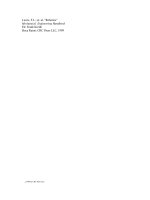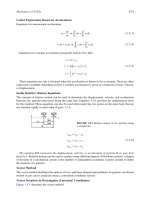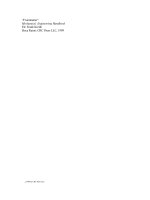Reservoir Engineering Handbook
Bạn đang xem bản rút gọn của tài liệu. Xem và tải ngay bản đầy đủ của tài liệu tại đây (148 KB, 1,211 trang )
Splitting and lumping schemes of the
plus-fraction 1137
Splitting schemes 1138
Lumping schemes 1148
Problems 1155
References 1159
APPENDIX 1165
INDEX 1177
Second Edition
Reservoir Eng FOB 2001-10-29 16:18 Page i
Reservoir Eng FOB 2001-10-29 16:18 Page ii
Gulf Professional Publishing
Boston • London • Auckland • Johannesbourg • Melbourne • New Delhi
Second Edition
Reservoir Eng FOB 2001-10-29 16:18 Page iii
Gulf Professional Publishing is an imprint of Butterworth-Heinemann.
Copyright © 2001 by Butterworth-Heinemann
A member of the Reed Elsevier group
Previously copyrighted © 2000 by Gulf Publishing Company, Houston, Texas
All rights reserved.
No part of this publication may be reproduced, stored in a retrival system, or
transmitted in any form or by any means, electronic, mechanical,
photocopying, recording, or otherwise, without the prior written permission of
the publisher.
Recognizing the importance of preserving what has been written,
Butterworth-Heinemann prints its books on acid-free paper
whenever possible.
Library of Congress Cataloging-in-Publication Data
Ahmed, Tared H., 1946-
Reservoir engineering handbook / Tarek Ahmed.
p.cm.
Includes bibliographical references and index.
ISBN 0-88415-770-9 (alk. paper)
1. Oil reservoir engineering. 2. Oil fields. 3. Gas reservoirs. I. Title.
TN871 .A337 2000
622’.3382 dc21
99-005377
British Library Cataloguing-in-Publication Data
A catalogue record for this book is available from the British Library.
The publisher offers special discounts on bulk orders of this book. For
information, please contact:
Manager of Special Sales
Butterworth-Heinemann
225 Wildwood Avenue
Woburn, MA 01801–2041
Tel: 781-904-2500
Fax: 781-904-2620
For information on all Butterworth-Heinemann publications available, contact
our World Wide Web home page at:
10 9 8 7 6 5 4 3 2 1
Printed in the United States
Reservoir Eng FOB 2001-10-29 16:18 Page iv
To my gorgeous wife Shanna,
And my beautiful children
Jennifer
Justin
Brittany
Carsen
Reservoir Eng FOB 2001-10-29 16:18 Page v
ACKNOWLEDGMENTS xiii
PREFACE TO THE SECOND EDITION xiv
PREFACE TO THE FIRST EDITION xv
1 FUNDAMENTALS OF RESERVOIR
FLUID BEHAVIOR 1
Classification of reservoirs and reservoir
fluids 1
Pressure-temperature diagram 2
Oil reservoirs 4
Gas reservoirs 10
Undefined petroleum fractions 24
Problems 27
References 28
2 RESERVOIR-FLUID PROPERTIES 29
Properties of natural gases 29
Behavior of ideal gases 30
Behavior of real gases 36
Effect of nonhydrocarbon components of
the Z-factor 44
Nonhydrocarbon adjustment methods 45
The Wichert-Aziz correction method 45
Correction for high-molecular weight
gases 49
Direct calculation of compressibility
factors 54
Compressibility of natural gases 59
Gas formation volume factor 65
Gas viscosity 67
Methods of calculating the viscosity of
natural gases 68
Properties of crude oil systems 74
Crude oil gravity 75
Specific gravity of the solution gas 76
Gas solubility 77
Bubble-point pressure 86
Oil formation volume factor 92
Isothermal compressibility coefficient of
crude oil 98
Oil formation volume factor for
undersaturated oils 103
Crude oil density 106
Crude oil viscosity 108
Methods of calculating viscosity of the
dead oil 109
Methods of calculating the saturated oil
viscosity 111
Methods of calculating the viscosity of
the undersaturated oil 112
Surface/interfacial tension 115
Properties of reservoir water 118
Water formation volume factor 118
Water viscosity 119
Gas solubility in water 119
Water isothermal compressibility 120
Problems 120
References 126
3 LABORATORY ANALYSIS OF
RESERVOIR FLUIDS 130
Composition of the resevoir fluid 131
Constant-composition expansion tests 131
Differential liberation (vaporization) test 143
Separator tests 146
Adjustment of differential liberation data
to separator conditions 151
Extrapolation of resevoir fluid data 158
Correcting constant-composition
expansion data 158
Correcting differential liberation data 160
Correcting oil viscosity data 161
Correcting the separator tests data 163
Laboratory analysis of gas condensate
systems 165
Recombination of separator samples 165
Constant-composition test 168
Constant-volume depletion (CVD) test 170
Problems 178
References 182
4 FUNDAMENTALS OF ROCK
PROPERTIES 183
Porosity 184
Absolute porosity 184
Effective porosity 185
Saturation 189
Average saturation 191
Wettability 193
Surface and interfacial tension 194
Capillary pressure 197
Capillary pressure of reservoir rocks 200
Capillary hysteresis 203
Initial saturation distribution in a reservoir 206
Leverett J-function 218
Converting laboratory capillary pressure
data 221
Permeability 221
The Klinkenberg effect 228
Averaging absolute permeabilities 235
Weighted-average
permeability 236
Harmonic-average
permeability 239
Geometric-average
permeability 243
Absolute permeability correlations 244
Rock compressibility 248
Net pay thickness 254
Resevoir heterogeneity 255
Vertical Heterogeneity 256
Areal heterogeneity 268
Problems 273
References 278
5 RELATIVE PERMEABILITY
CONCEPTS 280
Two-phase relative permeability 281
Drainage process 285
Imbibition process 286
Two-phase relatie permeability
correlations 286
1 Wyllie and Gardner correlation 288
2 Torcaso and Wyllie correlation 289
3 Pirson’s correlation 289
4 Corey’s method 291
5 Relative permeability from capillary
pressure data 292
6 Relative permeability from analytical
equations 294
Relative permeability ratio 298
Dynamic pseudo-relative permeabilities 301
Normalization and averaging realtive
permeability data 304
Three-phase relative permeability 310
Three-phase relative permeability
correlations 312
Wyllie’s correlations 313
Stone’s model I 314
Stone’s model II 316
The Hustad-Holt correlation 316
Problems 319
References 320
6 FUNDAMENTALS OF RESERVOIR
FLUID FLOW 321
Types of fluid 322
Flow regimes 324
Resevoir geometry 326
Number of flowing fluids in the resevoir 329
Fluid flow equations 330
Darcy’s Law 331
Steady-state flow 332
Linear flow of incompressible fluids 333
Linear flow of slightly compressible fluids 339
Linear flow of compressible fluids (gases) 341
Radial flow of incompressible fluids 344
Radial flow of slightly compressible fluids 350
Radial flow of compressible gases 352
Horizontal multiple-phase flow 360
Unsteady-state flow 363
Basic transient flow equation 365
Radial flow of slightly compressible fluids 370
Constant-terminal-pressure solution 374
Constant-terminal-rate solution 374
The E-function solution 375
The dimensionless pressure drop (Pd)
solution 383
Radial flow of compressible fluids 392
The m(p)-solution method
(exact-solution) 395
The pressure-squared approximation
method (p2-method) 398
The pressure-approximation method 400
Pseudosteady-state flow 403
Radial flow of slightly compressible fluids 409
Radial flow of compressible fluids
(gases) 418
Pressure-squared approximation method 419
Pressure-approximation method 419
Skin factor 420
Turbulent flow factor 426
Principle of superposition 431
Effects of multiple wells 432
Effects of variable flow rates 435
Effects of the reservoir boundary 438
Accounting for pressure-change effects 442
Transient well testing 442
Drawdown test 443
Pressure buildup test 456
Problems 465
References 471
7 OIL WELL PERFORMANCE 473
Vertical oil well performance 473
Productivity index and IPR 473
Vogel’s method 482
Saturated oil reservoirs 483
Undersaturated oil reservoirs 485
Wiggins’ method 491
Standing’s method 494
Fetkovich’s method 498
The Klins-Clark method 514
Horizontal oil well performance 515
Method I 516
Method II 517
Horizontal well productivity under
steady-state flow 519
Borisov’s method 520
The Giger-Reiss-Jourdan method 520
Joshi’s method 521
The Renard-Dupuy method 522
Horizontal well productivity under
semisteady-state flow 527
Problems 529
References 531
8 GAS WELL PERFORMANCE 533
Vertical gas well performance 533
Region I. High-pressure region 536
Region II. Intermediate-pressure region 537
Region III. Low-pressure region 537
The simpified treatment approach 543
The Laminar-Inertial-Turbulent (LIT)
approach 545
The Back-Pressure test 550
Future inflow performance relationships 559
Horizontal gas well performance 562
Problems 566
References 568
9 GAS AND WATER CONING 569
Coning 570
Coning in vertical wells 573
Vertical well critical rate correlations 573
The Meyer-Garder
correlation 574
The Chierici-Ciucci approach 581
The
Hoyland-Papatzacos-Skjaeve
methods 593
Critical rate curves by
Chaney et al. 597
Chaperson’s method 604
Schols’ method 605
Breakthrough time in vertical wells 606
The Sobocinski-Cornelius method 606
The Bournazel-Jeanson method 609
After breakthrough performance 610
Coning in horizontal wells 615
Horizontal well critical rate correlations 616
Chaperson’s method 616
Efros’ method 620
Karcher’s method 621
Joshi’s method 622
Horizontal well breakthrough time 624
The Ozkan-Raghavan method 624
Papatzacos’ method 627
Problems 632
References 634
10 WATER INFLUX 636
Classification of aquifers 637
Degree of pressure maintenance 637
Outer boundary conditions 639
Flow regimes 639
Flow geometries 639
Recognition of natural water influx 640
Water influx models 641
The pot aquifer model 642
Schilthuis’ steady-state model 645
Hurst’s modified steady-state model 649
The Van Everdingen-Hurst
unsteady-state model 653
The edge-water drive 654
Bottom-water drive 677
The Carter-Tracey water influx model 703
Fetkovich’s method 707
Problems 713
References 716
11 OIL RECOVERY MECHANISMS
AND THE MATERIAL BALANCE
EQUATION 717
Primary recovery mechanisms 718
Rock and liquid expansion 718
The depletion drive mechanism 719
Gas cap drive 721
The water-drive mechanism 726
The gravity-drainage-drive mechanism 730
The combination-drive mechanism 735
The material balance equation 736
Basic assumptions in the MBE 751
The MBE as an equation of a straight line 753
The straight-line solution method to the
MBE 755
Case 1. Volumetric undersaturated-oil
resevoirs 755
Case 2. Volumetric saturated-oil
reservoirs 760
Case 3. Gas-cap-drive reservoirs 762
Case 4. Water-drive reservoirs 766
The pot-aquifer model in the
MBE 768
The steady-state model in
the MBE 769
The unsteady-state model in
the MBE 770
Tracy’s form of the material balance
equation 774
Problems 778
References 781
12 PREDICTING OIL RESERVOIR
PERFORMANCE 782
Phase 1. Reservoir performance
prediction methods 783
Instantaneous gas-oil ratio 783
The resevoir saturation equations 789
Undersaturated-oil reservoirs 797
Saturated-oil reservoirs 801
Tracy’s method 803
Muskat’s method 810
Tarner’s method 815
Phase 2. Relating reservoir performance
to time 822
Problems 825
References 826
13 GAS RESERVOIRS 827
The volumetric method 828
The material balance method 831
Volumetric gas reservoirs 832
Form 1. In terms of p/z 833
Form 2. In terms of Bg 838
Water-drive gas reservoirs 840
Material balance equation as a straight
line 842
Abnormally pressured gas reservoirs 847
Effect on gas production rate on ultimate
recovery 853
Problems 854
References 856
14 PRINCIPLES OF WATERFLOODING 857
Factors to consider in waterflooding 858
Reservoir geometry 859
Fluid properties 859
Reservoir depth 859
Lithology and rock properties 860
Fluid saturations 861
Reservoir uniformity and pay continuity 861
Primary reservoir driving mechanisms 861
Optimum time to waterflood 863
Effect of trapped gas on waterflood
recovery 865
First theory 865
Second theory 866
Selection of flooding patterns 875
Irregular injection patterns 875
Irregular injection patterns 875
Peripheral injection patterns 876
Regular injection patterns 878
Crestal and basal injection patterns 879
Overall recovery efficiency 880
I. Displacement efficiency 881
II. Areal sweep efficiency 932
III. Vertical sweep efficiency 989
Calculation of vertical sweep efficiency 997
Methods of predicting recovery
performance for layered reservoirs 1006
Simplified Dykstra-Parsons method 1006
Modified Dykstra-Parsons method 1010
Craig-Geffen-Morse method 1013
Problems 1016
References 1024
15 VAPOR-LIQUID PHASE
EQUILIBRIA 1026
Vapor pressure 1026
Equilibrium ratios 1029
Flash calculations 1033
Equilibrium ratios for real solutions 1037
Wilson’s correlation 1038
Standing’s correlation 1038
Convergence pressure method 1043
Whitson and Torp correlation 1049
Equilibrium ratios for the plus fraction 1050
Campbell’s method 1051
Winn’s method 1051
Katz’s method 1052
Applications of the equilibrium ratio in
reservoir engineering 1052
Dew-point pressure 1053
Bubble-point pressure 1055
Separator calculations 1058
Density calculations 1072
Equations of state 1084
The Van der Waals equation of state 1084
Redlick-Kwong equation of state 1092
Soave-Redlick-Kwong equation of state
and its modifications 1098
Modifications of the SRK EOS 1108
Peng-Robinson equation of state and its
modifications 1112
Applications of the equation of state in
petroleum engineering 1124
Determination of the equilibrium ratios 1124
Determination of the dew-point pressure 1125
Determination of the bubble-point
pressure 1128
Three-phase equilibrium calculations 1129
Vapor pressure from equilibrium of state 1135
Much of the material on which this book is based was drawn from the
publications of the Society of Petroleum Engineers. Tribute is due to the
SPE and the petroleum engineers, scientists, and authors who have made
numerous and significant contributions to the field of reservoir engineer-
ing. I would like to express my appreciation to a large number of my col-
leagues within the petroleum industry and academia who offered sugges-
tions and critiques on the first edition; special thanks go to Dr. Wenxia
Zhang with TotalFinaElf E&P USA, Inc, for her suggestions and encour-
agements. I am also indebted to my students at Montana Tech of the Uni-
versity of Montana, whose enthusiasm has made teaching a pleasure; I
think! Special thanks to my colleagues and friends: Dr. Gil Cady, Profes-
sor John Evans; and Dr. Margaret Ziaja for making valuable suggestions
for the improvement of this book. I would like to acknowledge and
express my appreciation to Gary Kolstad, Vice President and General
Manager with Schlumberger, and Darrell McKenna, Vice President with
Schlumberger; for their continued support.
I would like to thank the editorial staff of Butterworth-Heinemann and
Gulf Professional Publishing for their concise and thorough work. I
greatly appreciate the assistance that Karen Forster has given me during
my work on the second edition.
xiii
ACKNOWLEDGMENTS
Reservoir Eng FOB 2001-10-29 16:18 Page xiii
I have attempted to construct the chapters following a sequence that I
have used for several years in teaching three undergraduate courses in
reservoir engineering. Two new chapters have been included in this sec-
ond edition; Chapter 14 and 15. Chapter 14 reviews principles of water-
flooding with emphasis on the design of a waterflooding project. Chapter
15 is intended to introduce and document the practical applications of
equations of state in the area of vapor-liquid phase equilibria. A compre-
hensive review of different equations of state is presented with an
emphasis on the Peng-Robinson equation of state.
xiv
PREFACE TO THE
SECOND EDITION
Reservoir Eng FOB 2001-10-29 16:18 Page xiv
This book explains the fundamentals of reservoir engineering and their
practical application in conducting a comprehensive field study. Chapter
1 reviews fundamentals of reservoir fluid behavior with an emphasis on
the classification of reservoir and reservoir fluids. Chapter 2 documents
reservoir-fluid properties, while Chapter 3 presents a comprehensive
treatment and description of the routine and specialized PVT laboratory
tests. The fundamentals of rock properties are discussed in Chapter 4 and
numerous methodologies for generating those properties are reviewed.
Chapter 5 focuses on presenting the concept of relative permeability and
its applications in fluid flow calculations.
The fundamental mathematical expressions that are used to describe
the reservoir fluid flow behavior in porous media are discussed in Chap-
ter 6, while Chapters 7 and 8 describe the principle of oil and gas well
performance calculations, respectively. Chapter 9 provides the theoretical
analysis of coning and outlines many of the practical solutions for calcu-
lating water and gas coning behavior. Various water influx calculation
models are shown in Chapter 10, along with detailed descriptions of the
computational steps involved in applying these models. The objective of
Chapter 11 is to introduce the basic principle of oil recovery mechanisms
and to present the generalized form of the material balance equation.
Chapters 12 and 13 focus on illustrating the practical applications of the
material balance equation in oil and gas reservoirs.
xv
PREFACE TO THE
FIRST EDITION
Reservoir Eng FOB 2001-10-29 16:18 Page xv
xvi
Reservoir Eng FOB 2001-10-29 16:18 Page xvi
Naturally occurring hydrocarbon systems found in petroleum reser-
voirs are mixtures of organic compounds which exhibit multiphase
behavior over wide ranges of pressures and temperatures. These hydro-
carbon accumulations may occur in the gaseous state, the liquid state, the
solid state, or in various combinations of gas, liquid, and solid.
These differences in phase behavior, coupled with the physical proper-
ties of reservoir rock that determine the relative ease with which gas and
liquid are transmitted or retained, result in many diverse types of hydro-
carbon reservoirs with complex behaviors. Frequently, petroleum engi-
neers have the task to study the behavior and characteristics of a petrole-
um reservoir and to determine the course of future development and
production that would maximize the profit.
The objective of this chapter is to review the basic principles of reser-
voir fluid phase behavior and illustrate the use of phase diagrams in clas-
sifying types of reservoirs and the native hydrocarbon systems.
CLASSIFICATION OF RESERVOIRS
AND RESERVOIR FLUIDS
Petroleum reservoirs are broadly classified as oil or gas reservoirs.
These broad classifications are further subdivided depending on:
1
CHAPTER 1
FUNDAMENTALS OF
RESERVOIR FLUID
BEHAVIOR
Reservoir Eng Hndbk Ch 01 2001-10-24 09:04 Page 1
• The composition of the reservoir hydrocarbon mixture
• Initial reservoir pressure and temperature
• Pressure and temperature of the surface production
The conditions under which these phases exist are a matter of consid-
erable practical importance. The experimental or the mathematical deter-
minations of these conditions are conveniently expressed in different
types of diagrams commonly called phase diagrams. One such diagram
is called the pressure-temperature diagram.
Pressure-Temperature Diagram
Figure 1-1 shows a typical pressure-temperature diagram of a multi-
component system with a specific overall composition. Although a dif-
ferent hydrocarbon system would have a different phase diagram, the
general configuration is similar.
2 Reservoir Engineering Handbook
Liquid
Gas
C
100%
Liquid
90%
70%
50%
5%
0%
F
B
A
E
Bubble-point Curve
Dew-point Curve
Two-phase Region
Temperature
Critical Poi
Pressure
Figure 1-1. Typical p-T diagram for a multicomponent system.
Reservoir Eng Hndbk Ch 01 2001-10-24 09:04 Page 2









